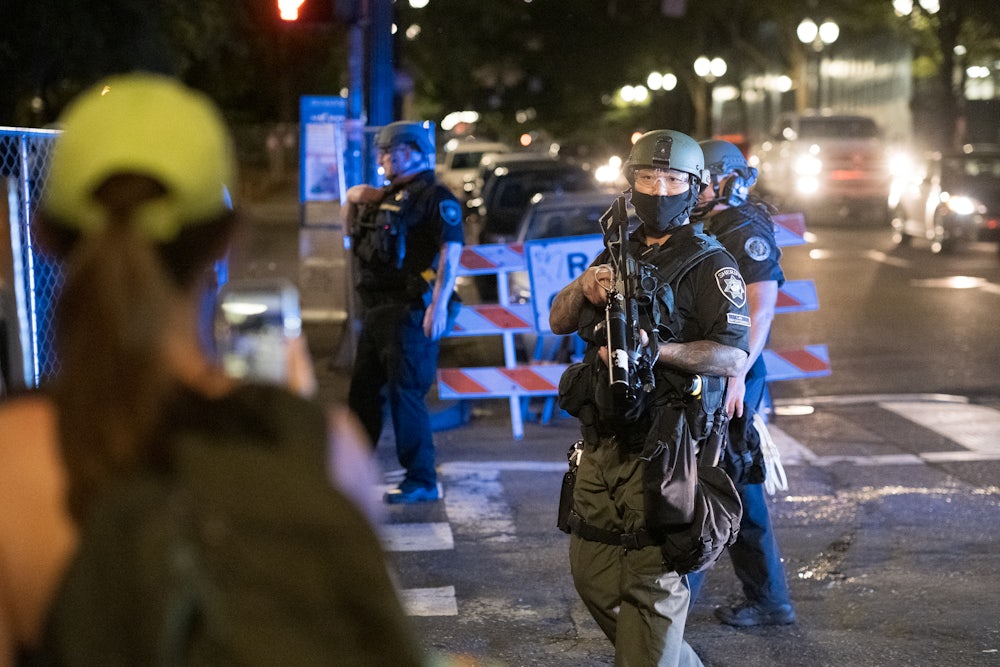In an outcome absolutely no one could have predicted, President Trump’s decision to send federal Department of Homeland Security agents into Portland, Oregon, ostensibly to protect statues, has led to violent crackdowns on protesters. On Saturday, a demonstrator was maimed by a “less lethal” munition, sustaining injuries that required facial reconstruction surgery. Just as disturbing is new evidence that federal agents in Portland are now abducting protesters in unmarked vehicles, as reported by Oregon Public Broadcasting on Thursday night.
Mark Pettibone, one such protester, was bundled into a minivan by unidentified officers early on Wednesday morning. Pettibone told OPB that while he was in the vehicle, the men pulled his beanie over his head and held his hands above his head. As for why he was picked up, Pettibone had no idea. He told OPB that he “just happened to be wearing black on a sidewalk in downtown Portland at the time,” but hadn’t been engaging in anything approaching violence or property damage. He was not provided with an explanation, was apparently not charged with any crime, and was released after he declined to be interrogated without a lawyer present. OPB reported that officers from the U.S. Marshals Special Operations Group and Customs and Border Protection’s tactical unit, BORTAC, have been seen in Portland, but the Marshals told the station that it was not they who arrested Pettibone.
As The Washington Post reported in its story about the arrest, Pettibone “did not know whether the men were police or far-right extremists, who frequently don militarylike outfits and harass left-leaning protesters in Portland.” When unknown men in uniform grab people off the street, or when lines of unidentified, armed men in riot gear (who refuse to tell reporters who they are) stand menacingly at the edges of a protest, it exposes the raw edge of brute force in this country’s version of law and order. It’s no longer about the state having a legitimate monopoly on violence; you no longer know whether the guy with a gun is just a nutjob from a militia or an actual police officer whose commands you must legally obey. The officers who detained Pettibone are barely operating within the confines of the law; they’re certainly not accountable in the way the police are supposed to be. (Both the mayor of Portland and the governor of Oregon have asked federal forces to leave, to no avail.)
Without any sort of attempt at legitimacy and accountability—or that thing we used to call due process—there’s little difference, in the moment, between a guy with a badge and a random kidnapper. Pettibone told OPB that he didn’t even realize he had been brought into a federal courthouse until after he was released; until that point, they were just guys with a minivan and guns, and there were more of them than there were of him, so they won. An encounter between members of a society quickly collapses into a crude calculation of relative power and force. The rules of schoolyard bullying become the foundation of “law and order.”
This is the consequence of police treating protests not just as vectors of potential violence but as an insurgency that must be quelled. Much has been said about how local police forces buying up absurd pieces of military hardware—in 2014, the Los Angeles school district’s police force returned some grenade launchers it had bought but kept its Mine Resistant Ambush Protected vehicles—represents the militarization of police. But Stuart Schrader, author of the book Badges Without Borders: How Global Counterinsurgency Transformed American Policing, has shown how the American military’s imperial project learned from the practices of American policing, not just the other way around. As Schrader pointed out on Democracy Now! last month, George Floyd “was killed by a police officer, in ordinary gear, who basically turned his body into a lethal weapon.” Some of the most horrifying and violent acts committed by police in response to the protests haven’t been marked by their use of military gear: Cops didn’t need advanced weaponry to fracture the skull of Martin Gugino, the 75-year-old protester who was casually pushed to the ground by a negligent police officer. Many, many others have been maimed by “less lethal” rounds, which have blinded or severely hurt a number of protesters.
All of this makes sense if you view, as Schrader does, the police response to the protests as a form of counterinsurgency, designed to put down insurrection and defeat an enemy force rather than maintain peace or order. Schrader noted in a Washington Post op-ed last month that these sorts of actions will breed further radicalization against the police, just as military activities in Iraq “created more insurgents than it stopped.” The world saw this dynamic play out in real time over the past several weeks, as aggressive police responses to largely peaceful protests created a cops-versus-protesters dynamic that engulfed several American cities.
The use of federal DHS officers makes the insurgency metaphor even more clear. Acting DHS Secretary Chad Wolf has embraced a militaristic messaging strategy, saying on Twitter that “our men and women in uniform are patriots” and that “we will prevail” against “violent anarchists.” But it’s unclear how Wolf imagines an ultimate victory will be achieved. Mass arrests? Martial law? He and the officers who serve under him seem to care more about getting to crack skulls than winning hearts and minds. But certainly, there is one very important person for whom this kind of violence is an end in itself. And he happens to be president.
